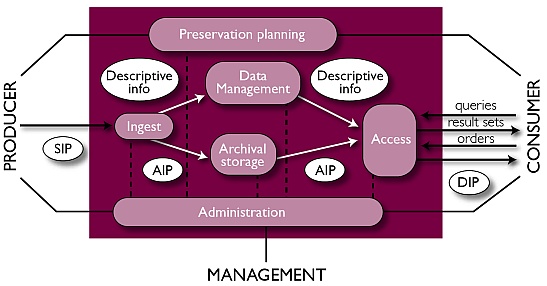6.1.8 The Open Archival Information System (OAIS)
6.1.8.1 The Reference Model for an Open Archival Information System (OAIS) is a widely adopted conceptual model for a digital repository and archival system. The OAIS reference model provides a common language and conceptual framework that digital library and preservation specialists now share. The framework has been adopted as an International Standard, ISO 14721:2003. Though some critics identify shortcomings in the detail of the OAIS, the concept of constructing repository architectures in a form that corresponds with the OAIS functional categories is critical to the development of modular storage systems with interoperable exchange of content. The following sections of the Guidelines adopt the major functional components of the OAIS reference model to assist in the analysis of the available software and to develop recommendations for necessary development.
6.1.8.2 There are a finite number of functions an archival digital repository must be able to perform in order for it to reliably and sustainably perform the purpose for which it is designed. These are defined in the Reference Model for an Open Archival Information System (OAIS) as Ingest, Access, Administration, Data Management, Preservation Planning and Archival Storage.

6.1.8.3 The OAIS also defines the structure of the various information packages that are necessary for the management of the data, according to the place in the digital life cycle. These are the Submission Information Package (SIP), Dissemination Information Package (DIP) and Archival Information Package (AIP). A package is the conceptual parcel of the data and relevant metadata and descriptive information necessary to the particular object. This object is conceptual only in the sense that the package contents may be dispersed in the system or collapsed into a single digital object. OAIS defines an information package as the Content Information and associated Preservation Description Information which is needed to aid in the preservation of the Content Information.
6.1.8.4 The SIP is an Information Package that is delivered to the system for ingest. It contains the data to be stored and all the necessary related metadata about object. The SIP is accepted into the system and used to create an AIP.
6.1.8.5 The AIP is an Information Package which is stored and preserved within the system. It is the information package the system stores, preserves and sustains.
6.1.8.6 The DIP is the information package created to distribute the digital content. There are three roles in this system. First is access, and this DIP would be in a form that the users can use and understand. Second is exchange for the purpose of distributing risk. An archival repository may choose to share parts of its content with other similar institutions, or with an organisation whose role is archival storage. In this case the DIP would contain all the relevant metadata necessary to undertake this role. The third is for distributing content to archives as a last resort. The scenario where a particular archive or institution no longer has the resources to maintain its collection is not difficult to imagine. A standard DIP for this purpose allows other similarly architected systems to undertake the role with the minimum of manual intervention.


